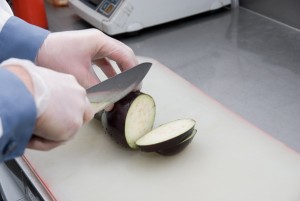Well, most of the news I see about “germs” being found somewhere or other are germophobia in some way or another. I think this is a different case though: Kitchen Cutting Boards Remain a Source of Multi-Drug Resistant Bacteria After Use. Not sure if what they report is particularly unusual but seems disconcerting at first glance. They report that 50% of the gloves they tested from hospital kitchen workers were contaminated with drug resistant E. coli. Does not sound like a good thing. Alas I cannot seem to find the paper that is behind this story (literally cannot find it – not sure why – and thus I do not even know if it is closed or open access …). Anyway – not sure what role the kitchens in hospitals play in hospital acquired illness, but if they play a big role it seems like it would be worth looking into the microbial ecology of said kitchens …

“Extended-Spectrum b-Lactamase
(ESBL)–Producing Enterobacteriaceae:
A Threat from the Kitchen” Sarah Tschudin-Sutter, MD, MSc; Reno Frei, MD; Roger Stephan, DVM; Herbert Hachler, PhD; Danica Nogarth; Andreas F. Widmer, MD, MSc. Infect Control Hosp Epidemiol 2014: 35(5): 581-584.
I am not sure why you had trouble finding this article. It is open access, available at http://www.jstor.org/stable/full/10.1086/675831
I posted it to our Mendeley collection just now.
I’d be curious to know your opinion after you have read the article.
thanks – not sure why I could not find the paper — though I note though it is currently available at no charge it does not appear to be “open access” (i.e., it does not have an open license applied to it that would allow easy sharing and reuse)
Interestingly, from 154 cutting boards sampled, only 10 (6.5%) were positive for ESBL-producing E. coli. No ESBL-producing enterobacterial species other than E. coli were detected. Of the 144 cutting boards sampled from different sites in the community, only 5/144 (3.4%) were contaminated.
The authors noted several limitations of their study including the fact that cutting boards were assessed in only one hospital. They also pointed out a possible bias attributable to the potentially more “standardized” collection of samples in the hospital by only one person compared with the collection of samples in private households in three different European countries.
I wonder whether this potential sample collection bias could also affect so-called “citizen science” projects where householders collect the samples?
I also wonder whether cutting boards are more contaminated than countertops, especially the grout between ceramic tiles. As grout ages and its surface deteriorates through aggressive cleaning, it becomes increasingly rough creating environmental “niches” where microbes can dwell and await arrival of sufficient moisture for replication and evolution. What is the impact of the products we use to clean our countertops and cutting boards on these processes?
The contamination found was associated with poultry processing, never from meat processing. This highlights the importance of the impact of human behavior (e.g., dietary choices) on (microbial) exposures in the indoor environment.
Even more fascinating to me is that while the prevalance of ESBL-producing E. coli is unknown but believed to be increasing worldwide, is that increase attributable to increased consumption of poultry rather the beef or pork meat, increased use of antibiotics in the meat and poultry production industries, or other human-behavior-dependent factors?
Our behaviors are important determinants of our exposures in the indoor environment, but behavior is a relatively neglected focus for exposure studies in the indoor environment research community.
Yes, I think having one person versus many people sampling could affect results but I think in the long run we will just have to accept that as a complicaiton of many studies. Certainly, the more standardized sampling is the easier it will be to compare studies done by different people / labs